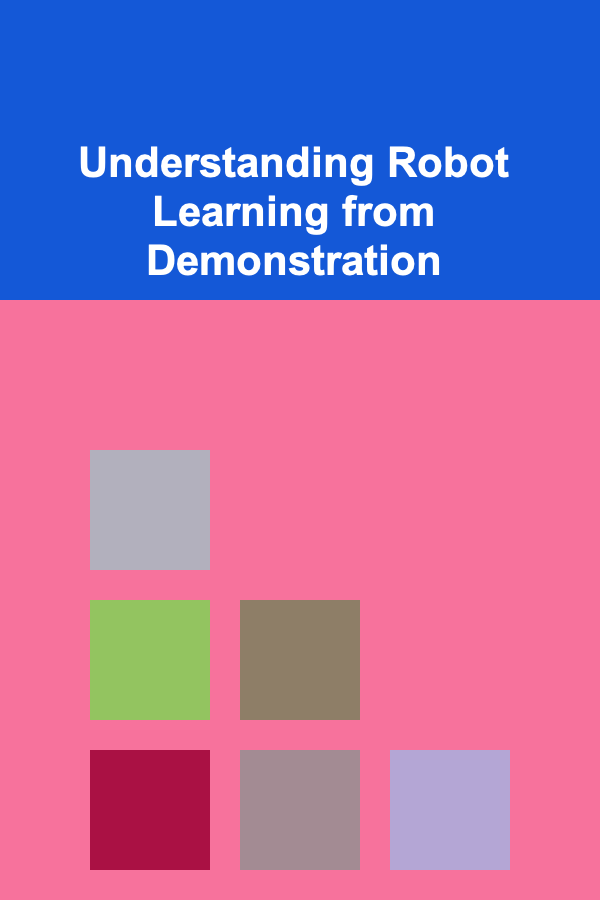
Understanding Robot Learning from Demonstration
ebook include PDF & Audio bundle (Micro Guide)
$12.99$8.99
Limited Time Offer! Order within the next:

Robot Learning from Demonstration (LfD), also known as Imitation Learning, is a powerful paradigm for teaching robots new skills. Instead of explicitly programming a robot or relying solely on reinforcement learning, LfD allows a robot to learn by observing demonstrations of the desired task performed by a human or another robot. This approach offers significant advantages in terms of ease of use, reduced development time, and the ability to teach complex skills that are difficult to specify analytically. However, understanding the intricacies of LfD, from data acquisition to algorithm selection and performance evaluation, is crucial for successful implementation. This article provides an in-depth exploration of LfD, covering its key concepts, techniques, challenges, and future directions.
The Fundamental Concepts of Learning from Demonstration
At its core, LfD aims to extract a policy or control strategy from observed data. This process typically involves several key steps:
- Data Acquisition: Gathering demonstrations of the desired task.
- Preprocessing: Cleaning, filtering, and transforming the demonstration data.
- Learning Algorithm: Employing a suitable learning algorithm to extract a policy from the preprocessed data.
- Policy Execution: Executing the learned policy on the robot.
- Evaluation: Assessing the performance of the learned policy.
Each of these steps presents its own set of challenges and opportunities. Understanding these challenges is critical for choosing the right LfD approach for a given task.
Data Acquisition: The Foundation of Imitation
The quality and quantity of demonstration data directly impact the performance of the learned policy. Data can be collected in several ways:
- Kinesthetic Teaching: The demonstrator physically guides the robot through the desired motion. This method is intuitive and provides direct control, but it can be physically demanding and may not be suitable for all robots or tasks.
- Teleoperation: The demonstrator controls the robot remotely using a joystick, glove, or other interface. Teleoperation allows for demonstrations in environments that are hazardous or inaccessible to humans, but it requires a calibrated and reliable control system.
- Visual Demonstration: The demonstrator performs the task while being recorded by cameras. The robot then learns from the visual data. This method is less intrusive than kinesthetic teaching or teleoperation, but it requires robust vision algorithms to track the demonstrator's movements and actions.
- Human-Robot Collaboration: The human and robot collaborate on the task, providing complimentary information. For instance, the human could guide the robot coarsely while the robot refines the trajectory using its sensors.
- Simulation: The demonstrations are generated within a simulated environment. This allows for easily generating large datasets and exploring various scenarios. However, transferring learned policies from simulation to the real world can be challenging due to the reality gap.
Regardless of the chosen method, it is crucial to ensure that the demonstrations are representative of the desired task and that they cover the range of possible scenarios. Poor demonstrations can lead to poor policies.
Preprocessing: Cleaning and Enhancing the Data
Raw demonstration data is often noisy, incomplete, or inconsistent. Preprocessing steps are essential for cleaning and preparing the data for the learning algorithm. Common preprocessing techniques include:
- Filtering: Removing noise and outliers from the data using techniques such as moving averages or Kalman filters.
- Segmentation: Dividing the demonstration into meaningful segments or phases. This is particularly important for complex tasks that involve multiple sub-actions. For example, segmenting the demonstration of cooking a meal into the phases: prepare ingredients, cook, plate, clean.
- Synchronization: Aligning multiple demonstrations to account for variations in timing and speed. Dynamic Time Warping (DTW) is a common technique for synchronizing time series data.
- Feature Extraction: Extracting relevant features from the raw data. For example, in visual demonstrations, features might include object positions, orientations, and color histograms.
- Dimensionality Reduction: Reducing the number of features to simplify the learning problem and improve generalization. Principal Component Analysis (PCA) and autoencoders are common techniques for dimensionality reduction.
The specific preprocessing steps required will depend on the nature of the demonstration data and the chosen learning algorithm.
Learning Algorithms: Extracting Policies from Demonstrations
A variety of learning algorithms can be used to extract policies from demonstration data. These algorithms can be broadly categorized into several classes:
- Behavior Cloning (BC): This is the simplest LfD approach. BC treats the demonstration data as a supervised learning problem, where the robot's state is the input and the demonstrator's action is the output. A standard supervised learning algorithm, such as a neural network or support vector machine, is then trained to map states to actions. While simple to implement, BC suffers from several limitations, including compounding errors (where small errors accumulate over time, leading to divergence from the desired trajectory) and the inability to generalize to states not seen in the demonstrations.
- Inverse Reinforcement Learning (IRL): IRL aims to infer the reward function that the demonstrator was optimizing when performing the task. Once the reward function is learned, a reinforcement learning algorithm can be used to train a policy that maximizes the reward. IRL is more robust than BC because it explicitly models the underlying goals of the task. However, IRL can be computationally expensive and may require strong assumptions about the structure of the reward function.
- Dynamic Movement Primitives (DMPs): DMPs provide a framework for representing and learning movements. A DMP consists of a set of differential equations that describe the desired trajectory. The parameters of the DMP can be learned from demonstration data. DMPs are particularly well-suited for learning rhythmic or repetitive movements. They offer good generalization capabilities and are relatively easy to implement.
- Gaussian Mixture Regression (GMR): GMR models the joint probability distribution of states and actions using a mixture of Gaussian distributions. This allows the system to estimate the most likely action given the current state. GMR is useful for representing complex, multi-modal behaviors and can handle noisy data effectively.
- Generative Adversarial Imitation Learning (GAIL): GAIL uses a generative adversarial network (GAN) to learn a policy that mimics the demonstrator's behavior. The generator network learns to generate actions, while the discriminator network tries to distinguish between the generated actions and the actions in the demonstration data. GAIL is more robust to variations in the demonstration data than BC and can learn more complex policies.
- Hidden Markov Models (HMMs): HMMs are probabilistic models that can represent sequential data. In the context of LfD, HMMs can model the different states of the demonstration and the transitions between them. They are particularly useful for tasks with distinct phases or sub-actions.
The choice of learning algorithm depends on the specific task, the available data, and the desired performance characteristics. Some algorithms are better suited for learning continuous motions, while others are better suited for learning discrete actions. Some algorithms are more robust to noise and variations in the demonstration data than others.
Policy Execution and Evaluation
Once a policy has been learned, it must be executed on the robot. This involves converting the policy into a set of control commands that the robot can understand. The performance of the learned policy must then be evaluated. This can be done by measuring the robot's performance on a set of test tasks.
Evaluation metrics will depend on the specific task. For example, if the task is to pick up an object, the evaluation metrics might include the success rate (the percentage of times the robot successfully picks up the object), the time taken to pick up the object, and the accuracy of the grasp. For trajectory following tasks, metrics might include root mean squared error (RMSE) between the desired and actual trajectory, and maximum deviation from the target path.
It is important to evaluate the learned policy on a diverse set of test tasks to ensure that it generalizes well to new situations. Also, comparing the performance with different baseline methods helps establish the value of the LfD approach.
Challenges in Learning from Demonstration
Despite its promise, LfD faces several challenges:
- The Correspondence Problem: The robot and the demonstrator may have different morphologies, kinematics, and dynamics. This makes it difficult to directly map the demonstrator's actions to the robot's actions. For example, a human demonstrator might use their arm to reach for an object, while a robot might use a different type of manipulator. Solving the correspondence problem requires finding a common representation of the task that is independent of the specific embodiment of the robot and the demonstrator.
- The Exploration Problem: LfD algorithms typically only learn from the demonstrated data. This can lead to poor performance in situations that are not covered by the demonstrations. To address this, some LfD algorithms incorporate exploration strategies that allow the robot to explore the environment and discover new solutions. However, careful design is needed to balance exploration with exploitation of learned knowledge.
- The Problem of Suboptimal Demonstrations: The demonstrator may not always provide optimal demonstrations. For example, the demonstrator might make mistakes or take shortcuts. This can lead to the robot learning a suboptimal policy. To mitigate this, techniques like filtering noisy demonstrations or learning from multiple demonstrators can be employed.
- The Generalization Problem: LfD algorithms must be able to generalize from the demonstrated data to new situations. This can be challenging, especially when the environment is complex or unpredictable. The type of learning algorithm heavily influences generalization capabilities. More sophisticated algorithms like GAIL tend to generalize better than basic Behavior Cloning.
- The Reality Gap (for Simulation-Based LfD): Policies learned in simulation often perform poorly when transferred to the real world. This is due to discrepancies between the simulated and real environments, such as inaccurate physical models or unmodeled sensor noise. Techniques like domain randomization, where the simulation parameters are randomly varied during training, can help bridge the reality gap.
- Safety Constraints: Many robotic tasks require adherence to safety constraints. For instance, avoiding collisions with obstacles or staying within joint limits. Incorporating these constraints into the LfD framework is an ongoing research area. Techniques from constrained optimization and control barrier functions are being explored.
Addressing these challenges is an active area of research in LfD.
Advanced Techniques and Future Directions
Researchers are actively exploring advanced techniques to improve the performance and robustness of LfD. Some promising directions include:
- Deep Learning for LfD: Deep learning techniques, such as convolutional neural networks (CNNs) and recurrent neural networks (RNNs), are being used to learn complex policies from high-dimensional data, such as images and videos. Deep learning can also be used to learn representations of the environment that are invariant to changes in lighting, viewpoint, and other factors.
- Active Learning for LfD: Active learning algorithms allow the robot to actively query the demonstrator for additional demonstrations in areas where the robot is uncertain. This can significantly reduce the amount of demonstration data required to learn a good policy.
- Meta-Learning for LfD: Meta-learning algorithms allow the robot to learn how to learn new tasks from a small amount of demonstration data. This can enable the robot to quickly adapt to new environments and tasks.
- Hierarchical Learning for LfD: Hierarchical learning algorithms allow the robot to learn complex tasks by breaking them down into smaller, more manageable subtasks. This can improve the scalability and robustness of LfD.
- Multimodal Learning for LfD: Integrating different types of demonstration data (e.g., kinesthetic teaching, visual demonstration, and natural language instructions) can lead to more robust and versatile learning. Multimodal learning enables robots to understand the task from different perspectives.
- Explainable LfD: Making the learned policies more interpretable. Understanding why the robot performs a certain action can increase trust and facilitate debugging. Techniques from explainable AI (XAI) are being applied to LfD.
- Lifelong Learning for LfD: Enabling the robot to continuously learn and improve its skills over time, accumulating knowledge from multiple tasks and environments. This addresses the issue of catastrophic forgetting and allows for gradual skill improvement.
These advanced techniques hold the promise of making LfD a more powerful and practical tool for robot learning.
Applications of Learning from Demonstration
LfD has a wide range of potential applications in various domains, including:
- Manufacturing: Teaching robots to perform assembly tasks, inspection tasks, and other manufacturing operations.
- Healthcare: Training robots to assist surgeons, care for patients, and dispense medication.
- Service Robotics: Enabling robots to perform tasks such as cleaning, cooking, and delivering packages.
- Exploration and Rescue: Teaching robots to navigate hazardous environments, search for survivors, and defuse bombs.
- Agriculture: Training robots to harvest crops, plant seeds, and monitor livestock.
- Education: Assisting teachers in educational activities.
- Entertainment: Creating robotic entertainers or performers.
As LfD technology continues to advance, we can expect to see even more innovative applications emerge in the future.
Conclusion
Learning from Demonstration is a promising approach for teaching robots new skills. By leveraging the knowledge and expertise of human demonstrators, LfD can significantly reduce the effort required to program robots and enable them to perform complex tasks that would be difficult to specify analytically. However, successful implementation of LfD requires careful consideration of the various challenges and design choices involved, from data acquisition to algorithm selection and performance evaluation. As research continues to address these challenges and explore new techniques, LfD has the potential to revolutionize the way we interact with and program robots, enabling them to play a more significant role in our lives.

How to Make Money Online as a Sales Engineer: 10 Actionable Ideas
Read More
How to Reduce Subscription Services Costs in Your Home Budget
Read More
How to Select the Right Kitchen Appliances for Your Renovation
Read More
Supply Chain Visibility: Leveraging Technology to Enhance Decision-Making
Read More
How to Create Recipes with ChatGPT
Read More
How to Stay Connected with Your Team While Remote: A Comprehensive Guide
Read MoreOther Products

How to Make Money Online as a Sales Engineer: 10 Actionable Ideas
Read More
How to Reduce Subscription Services Costs in Your Home Budget
Read More
How to Select the Right Kitchen Appliances for Your Renovation
Read More
Supply Chain Visibility: Leveraging Technology to Enhance Decision-Making
Read More
How to Create Recipes with ChatGPT
Read More